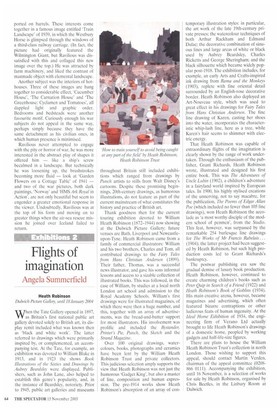Flights of imagination
Angela Summerfield
Heath Robinson
Dulwich Picture Gallety, until 18 January 2004
When the Tate Gallery opened in 1897, as Britain's first national public art gallery devoted solely to British art, its display remit included what was known then as 'black and white work'. The latter referred to drawings which were primarily inspired by, or complemented, an accompanying text. At the Tate, for example, an exhibition was devoted to William Blake in 1913, and in 1923 the shows Book Illustrations of the Sixties and Drawings by Aubrey Beardsley were displayed. Publishers, such as John Lane, also helped to establish this genre's popularity, and, in the instance of Beardsley, notoriety. Prior to 1945, public art galleries and museums
throughout Britain still included exhibitions which ranged from drawings by Punch artists to stills from Walt Disney's cartoons. Despite these promising beginnings, 20th-century drawings, as humorous illustrations, do not feature as part of the current mainstream of what constitutes the history and practice of British art.
Thank goodness then for the current touring exhibition devoted to William Heath Robinson (1872-1944) now showing at the Dulwich Picture Gallery; future venues are Bath. Liverpool and Newcastleupon-Tyne. Heath Robinson came from a family of commercial illustrators: William and his two brothers, Charles and Tom, all contributed drawings to the Fairy Tales from Hans Christian Andersen (1899). Their father, Thomas, was a successful news illustrator, and gave his sons informal lessons and access to a sizable collection of illustrated books. This was followed, in the case of William, by studies at a local north London art school and admission to the Royal Academy Schools. William's first drawings were for illustrated magazines, of which there were then a huge number, and this, together with an array of advertisements, was the bread-and-butter support for most illustrators. His involvement was prolific and included the Bystander, Printer's Pie, Punch, the Sketch and the Strand Magazine.
Over 100 original drawings, watercolours, books, photographs and ceramics have been lent by the William Heath Robinson Trust and private collectors. This judicious selection amply supports the view that Heath Robinson was not just the humorous 'Gadget King', but also a master of line, composition and human expression. The pre-1914 works show Heath Robinson's absorption of an array of con temporary illustration styles: in particular, the art work of the late 19th-century private presses; the watercolour techniques of both Arthur Rackham and Edmund Dulac; the decorative combination of sinuous lines and large areas of white or black used by Aubrey Beardsley, Charles Ricketts and George Sheringham; and the black silhouette which became widely popular post-1918. The exhibition includes, for example, an early Arts and Crafts-inspired ink drawing from Rama and the Monkeys (1903), replete with fine oriental detail surrounded by an English-rose decorative border. Heath Robinson also deployed an Art-Nouveau style, which was used to great effect in his drawings for Fait), Tales from Hans Christian Andersen. The fine line drawing of Karen, casting her shoes into the water, incorporates the characteristic whip-lash line, here as a tree, while Karen's hair seems to shimmer with electric energy.
That Heath Robinson was capable of extraordinary flights of the imagination is clearly shown by the range of work undertaken. Through the enthusiasm of the publisher, Grant Richards, Heath Robinson wrote, illustrated and designed his first entire book. This was The Adventures of Uncle Lubin (1902), a children's adventure in a fairyland world inspired by European tales. In 1900, his highly stylised creations of the unnerving, not to say macabre, for the publication, The Poems of Edgar Allan Poe (which included no fewer than 105 line drawings), won Heath Robinson the accolade as 'a most worthy disciple of the modern school of penmen', from the Studio. This feat, however, was surpassed by the remarkable 254 burlesque line drawings for The Works of Mr Francis Rabelais. . . (1904); the latter project had been suggested by Heath Robinson, but such high production costs led to Grant Richards's bankruptcy.
The postwar publishing era saw the gradual demise of luxury book production. Heath Robinson, however, continued to create charming children's books such as Peter Quip in Search of a Friend (1922) and Heath Robinson's Book of Goblins (1934). His main creative arena, however, became magazines and advertising, which often featured bizarre contraptions or other ludicrous feats of human ingenuity. At the Ideal Home Exhibition of 1934, the engineering firm of Verano Ltd actually brought to life Heath Robinson's drawings of a domestic home, peopled by working gadgets and half-life-size figures.
There are plans to house the William Heath Robinson Trust's collection in north London. Those wishing to support this appeal, should contact Martin Verden. chairman of the appeal committee (0208866 0111). Accompanying the exhibition, until 16 November, is a selection of works for sale by Heath Robinson, organised by Chris Beetles, in the Liribury Room at Dulwich.


























































































 Previous page
Previous page